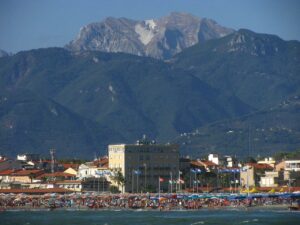Viareggio
Today is the revelation day in the Citadel.
Majestic creatures appear at the front door of the hangars, exposed to the sunlight for the first time like newborn puppies making their first entrance into the outside world.
However, it will be the public, not them, that has all the curiosity, as they are ready to impress and entertain the numerous visitors that the town has welcomed for the occasion.
It is February 3, and this is the first day of the 2024 Carnival in Viareggio, Tuscany.
Viareggio has one of the most popular and spectacular carnivals in Italy, with a tradition that stretches back almost 150 years. The first carnival was hosted in downtown Regia Street in 1873, but it was only in 1905 that it was moved to the broad promenade—one of the longest in Italy. Since then, this popular carnival parade travels past the elegant Art Nouveau and Art Deco buildings of the 20s and 30s.
What makes the Viareggio Carnival unique is the elaborate moving figures mounted on wagons, which made their first appearance in 1923 in a more basic, cruder form. Since then, the art has been refined and they have reached a sublime level, including the incredible dimensions of the floats.
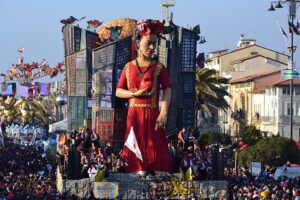
It is not possible to take in all the information they carry at once. The stories that are expressed through the vivid colors, the extravagant shapes and the realistic movements are complex and sometimes have several layers of symbolism.
Although the initial overall sight is enough to create astonishment and admiration among the crowd, as usual, a closer and more attentive look reveals crucial elements of the story. Then, once you go back to the overall, bigger picture, it should now be clearer and the political message of the big allegory will be even more powerful.
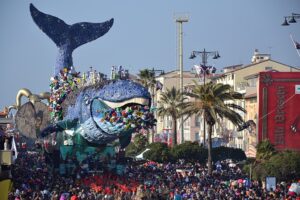
The highly entertaining floats are traditionally an instrument of satire, that openly criticize politicians’ actions and decisions, or express strong opinions about important issues of our time, like climate change.
This year, for instance, one float depicted AI. It showed a man sleeping on top of an ensemble of TV and computer screens, robots, and android characters. The float was called “SVEGL.IA”— it combines “sveglia”, the Italian word which pleads with the audience to “wake up” (it also means “alarm clock”) and the reference to Artificial intelligence—which is abbreviated to “IA” in Italian.
Among the floats, it is also usual to see characters from classic children’s tales which have been adapted to deliver a particular message. One example was when the Evil Queen from Snow White held the poisoned apple, not in front of our familiar pale-skinned young lady, but a representation of a beautiful, but weakened, planet Earth. This allegory float was the winner of one of the categories in 2019.
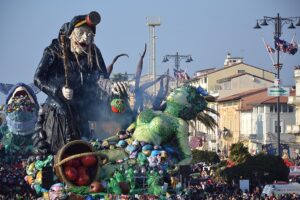
These gigantic wagons don’t parade on their own. Each one is supported by their own crowd, dressed up to match the story being told by the main float; both individual elements and the general theme of the plot. They walk and dance to the uplifting music played by huge powerful speakers mounted on their float.
This musical itinerant story covers just over a mile of the parade route for several days during the month of February, in front of the delighted eyes of the spectators on the streets of this Tuscan town. They throw confetti at the insolent masks, celebrate their bravery and beauty, and enjoy the music whose rhythm shakes their bodies right through to the bones.
What the spectators being entertained do not always know is that the allegorical floats are also part of a parallel, and serious, competition, which will crown the winner of each category by the end of the parade.
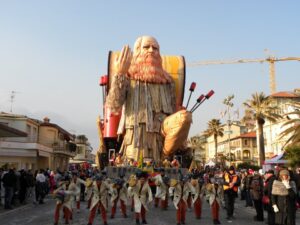
This year the carnival may have finished, but characters from Viareggio’s carnival are sending you a special invitation. Burlamacco, who is the official Carnival character of the Viareggio Carnival—and who made its first appearance in 1931—walks with a masked female character named Ondina, Italian for “Small Wave”, because she represents the summer when the coastline of Versilia is annually reborn. They are waving and inviting you to attend next year’s parade.
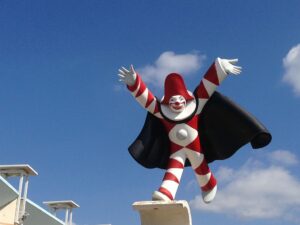
Today the charming sandy beaches of Versilia are empty but they are getting ready for the spring and the first sea bathers. Viareggio, in the province of Lucca on the 15-mile-long coastline of Versilia, is 1 hour and 30 minutes by train from Florence, and it is an ideal destination for both a relaxing and adventurous holiday.
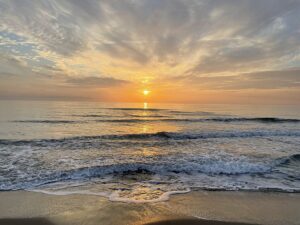
Apart from swimming in the calm waters of the Tyrrhenian Sea, there are plenty of opportunities to enjoy soothing strolls in the pine woods at the local parks, or a refreshing hike in the Apuan Alps.
If you are planning to visit Viareggio this summer, you can get an introduction to the Carnival spirit by paying a visit to the Carnival Museum to kick-start yourself ready for next year’s parade with Burlamacco and Ondina, perhaps dressed up as one of them.
